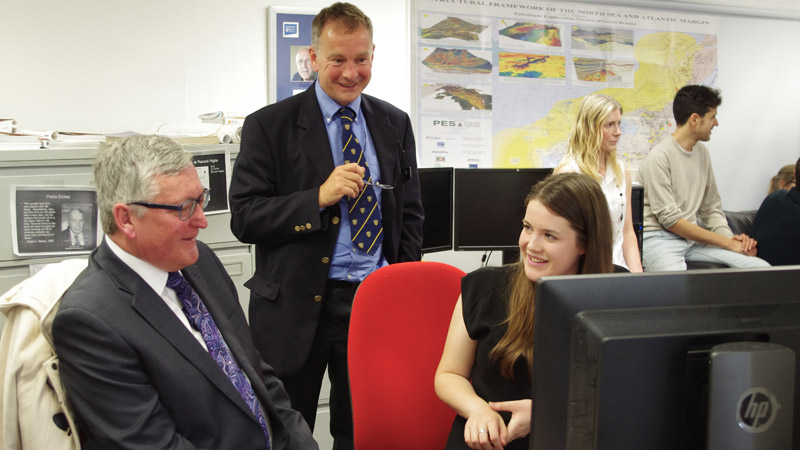
Fergus Ewing, Scottish Minister for Business, Energy and Tourism, explores the importance of geological interpretation for extending the life of the mature North Sea Basin.
The Acting Principal, Professor Julian Jones, and Professor John Underhill, the Shell Chair of Exploration Geoscience, welcomed the Scottish Minister for Business, Energy and Tourism, Fergus Ewing and NERC’s Director of Science and Innovation, Professor Ian Gillespie, to the University.
The Minister came on a fact-finding visit to learn more about the academic research being undertaken in the School of Energy, Geoscience Infrastructure and Society (EGIS)’s Wouter Hoogeveen seismic laboratory. The visitors were given an introduction to the background and objectives of the laboratory itself, the Shell Centre for Exploration Geoscience in which it is housed, and the NERC Centre for Doctoral Training (CDT) in Oil & Gas by their academic lead, Prof. John Underhill, before meeting PhD students in the laboratory.
The Minister met Rachael Hunter, one of the three NERC CDT PhD students undertaking their research at Heriot-Watt, and praised the collegiate approach that has brought together the expertise of 17 academic partners, 2 NERC affiliates and 9 industry sponsors for the benefit of the UK oil and gas sectors. Prof. Gillespie discussed the work of another of the NERC CDT PhD students, Ross Grant and was pleased to hear of the benefits the students derive from the collective group training provided via the CDT, both to their current PhD studies as well as to their eventual career development plans.
Students showcase their research
The Minister and his aides received presentations by Dr. Rachel Jamieson and Gustavo Guariguata on their recent interpretations of seismic data from areas west of Shetland and the Moray Firth respectively. The Ministerial team commented on the value of this information in determining the strategy for both further exploration and production from these areas, as well as the opportunities for alternative use via Carbon Capture and Storage (CCS). There was particular interest in the forensic mapping and data analysis to understand the safe subsurface storage of carbon dioxide in saline aquifers and depleted oilfields.
Mr Ewing said, “I was very impressed by the range of work being undertaken by students at the NERC Centre for Doctoral Training and the Centre for Exploration Geoscience. Research such as this supports the oil and gas sector in innovating for the future. The Scottish Government remains committed to using every lever at its disposal to support the sector and I look forward to seeing the results of the various strands of research being undertaken.”
There was also plenty of opportunity for the visitors to discuss the value of widening public accessibility to recently generated seismic data and the importance of forging links with the new Oil and Gas Authority (OGA) to ensure effective knowledge exchange to aid in understanding the complexities and overcoming the challenges the Basin now presents geoscientists with.
Future Ministerial Support to the CDT
The visit ended with an invitation being extended to the Minister to attend the First Annual CDT conference, being held on November 2nd 2015 at Heriot-Watt, as a further opportunity to view the first year research results of the inaugural student cohort and experience the unique esprit de corps of this UK-wide group of students and the CDT’s collaboration between academia and industry. Mr Ewing expressed his desire to attend pending his other diary commitments for this date.
John Underhill, Heriot-Watt’s Shell Professor of Exploration Geoscience and Academic Lead for NERC’s UK Centre for Doctoral Training (CDT) in Oil & Gas said: “The visit provided an excellent opportunity for the academic research group to present their latest interpretations. The results of the studies have direct and important consequences, not only for understanding remaining petroleum exploration opportunities, but also for the forensic examination of carbon storage potential that the North Sea’s saline aquifers and depleted oilfields present.”
